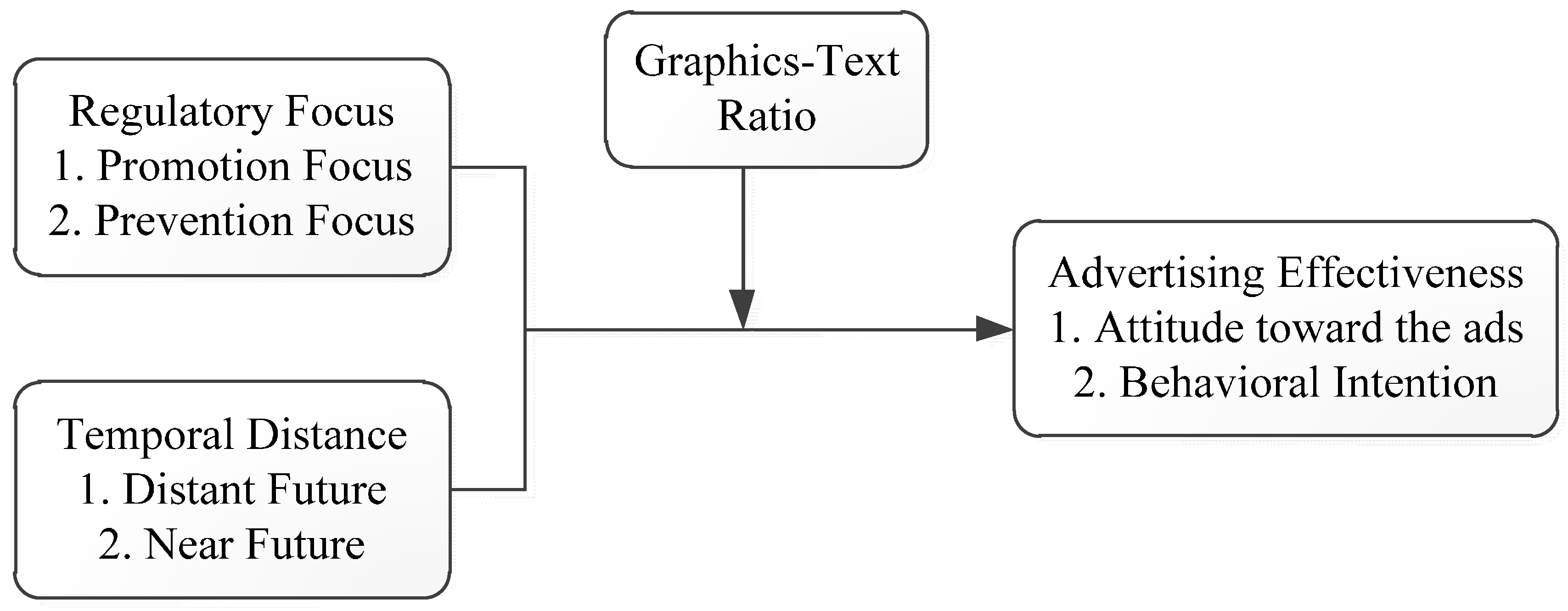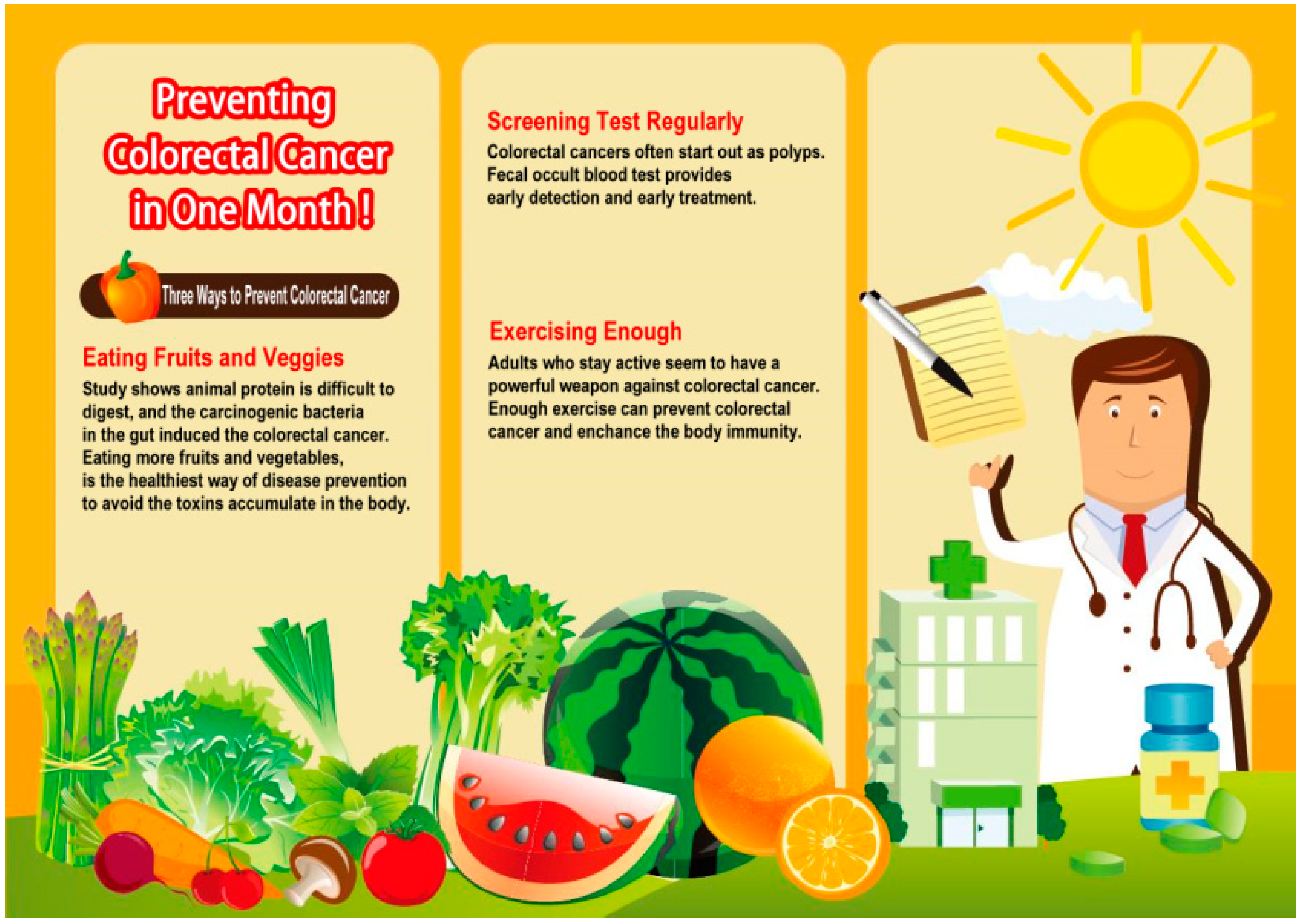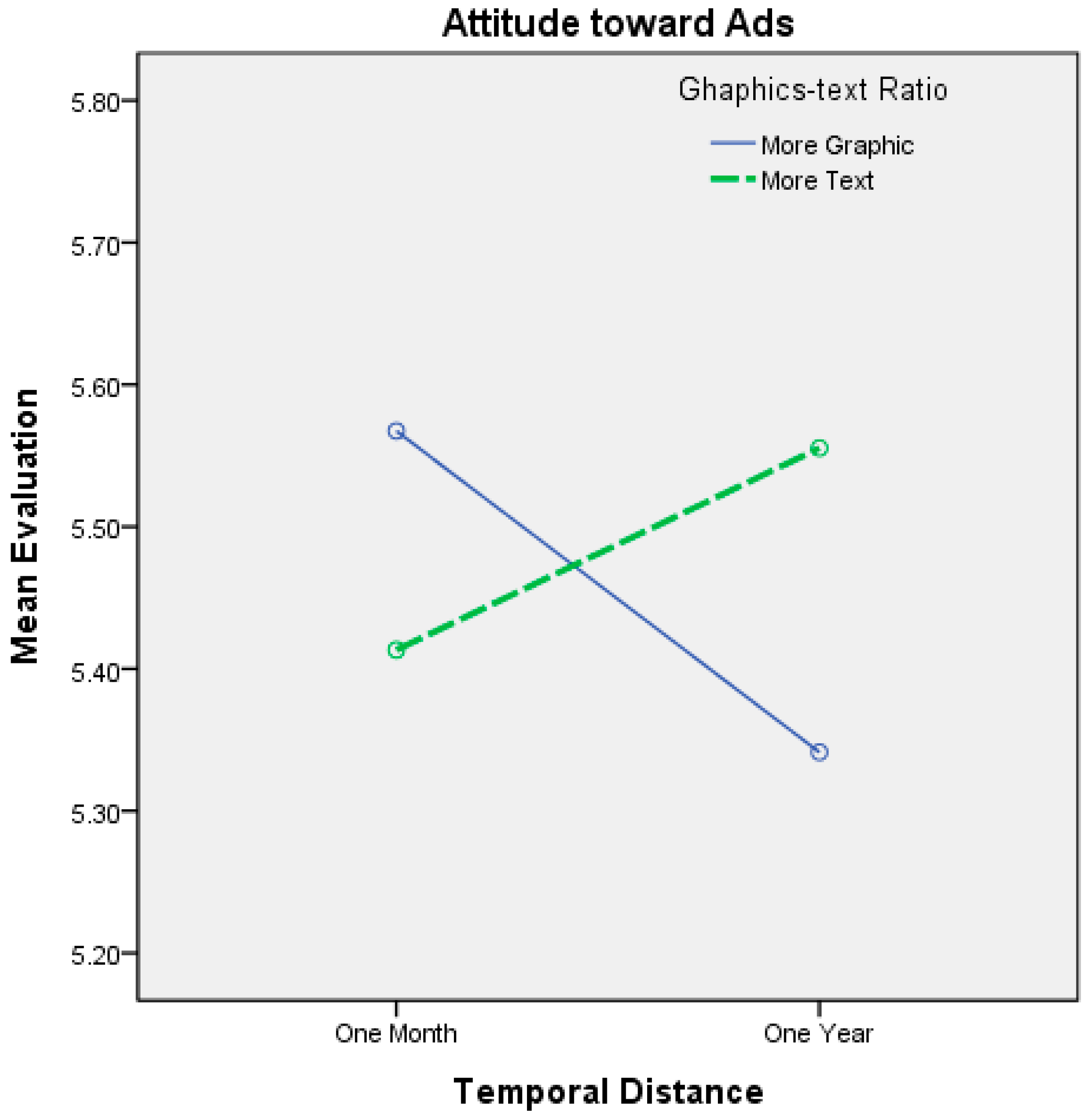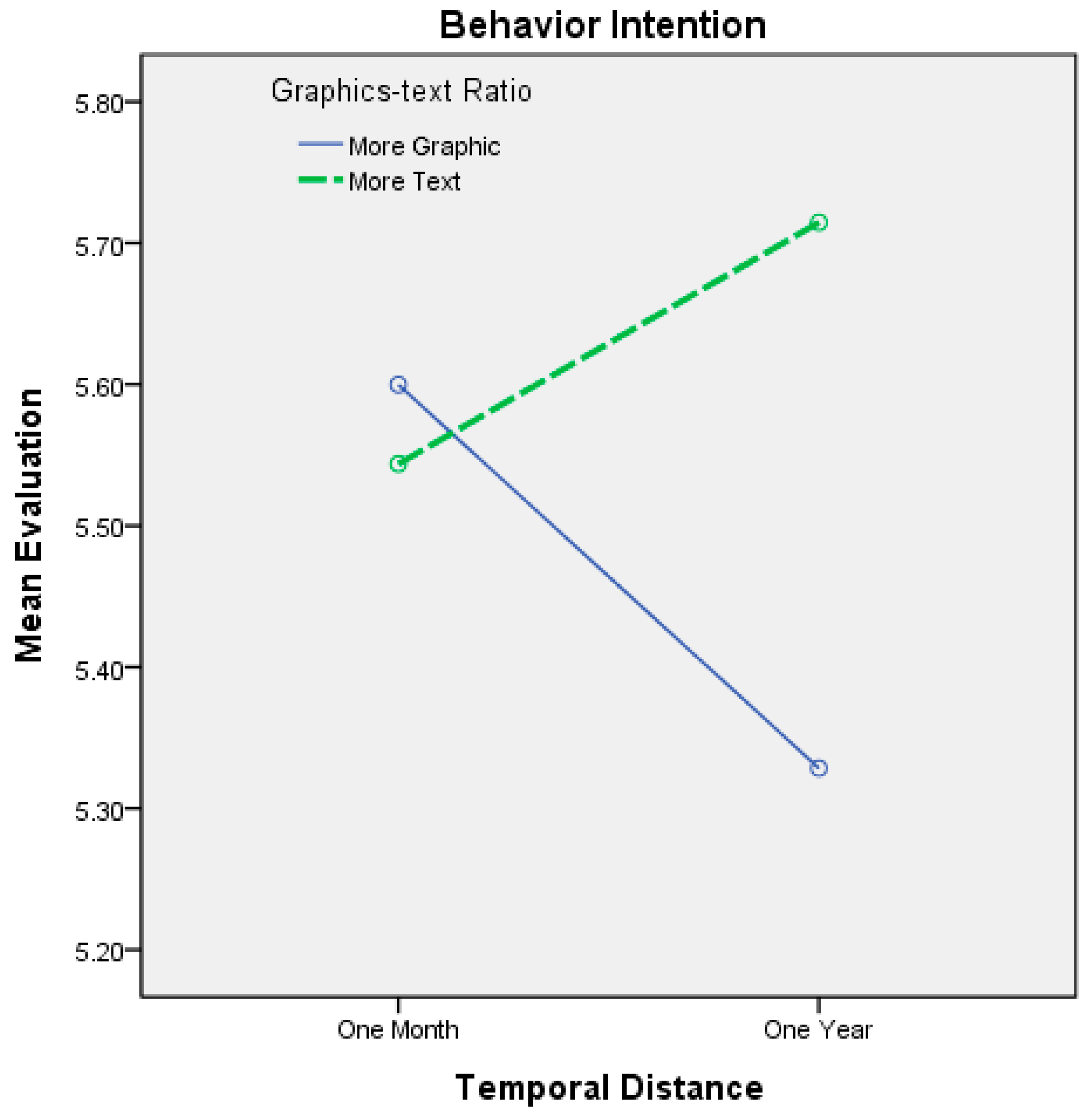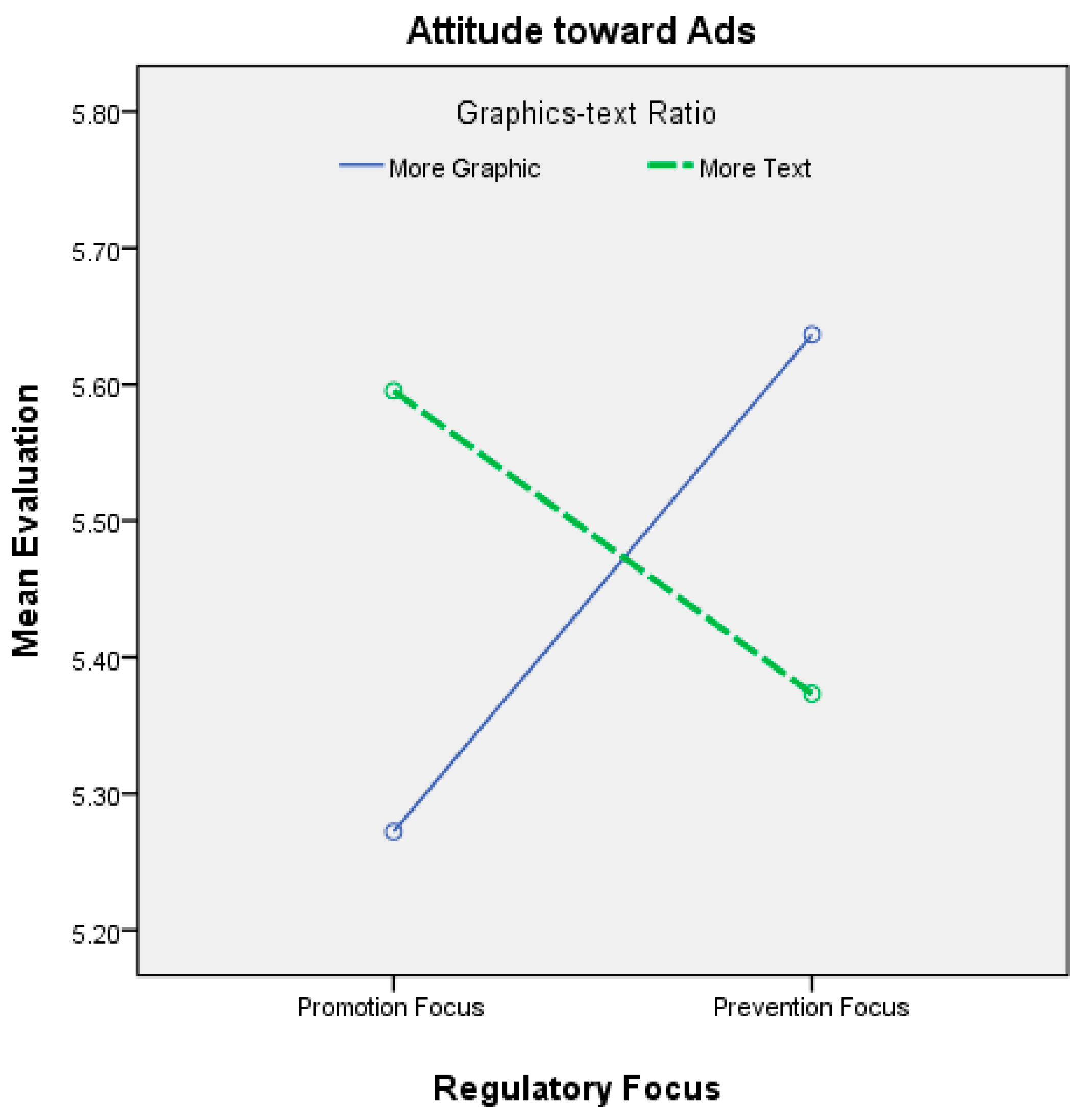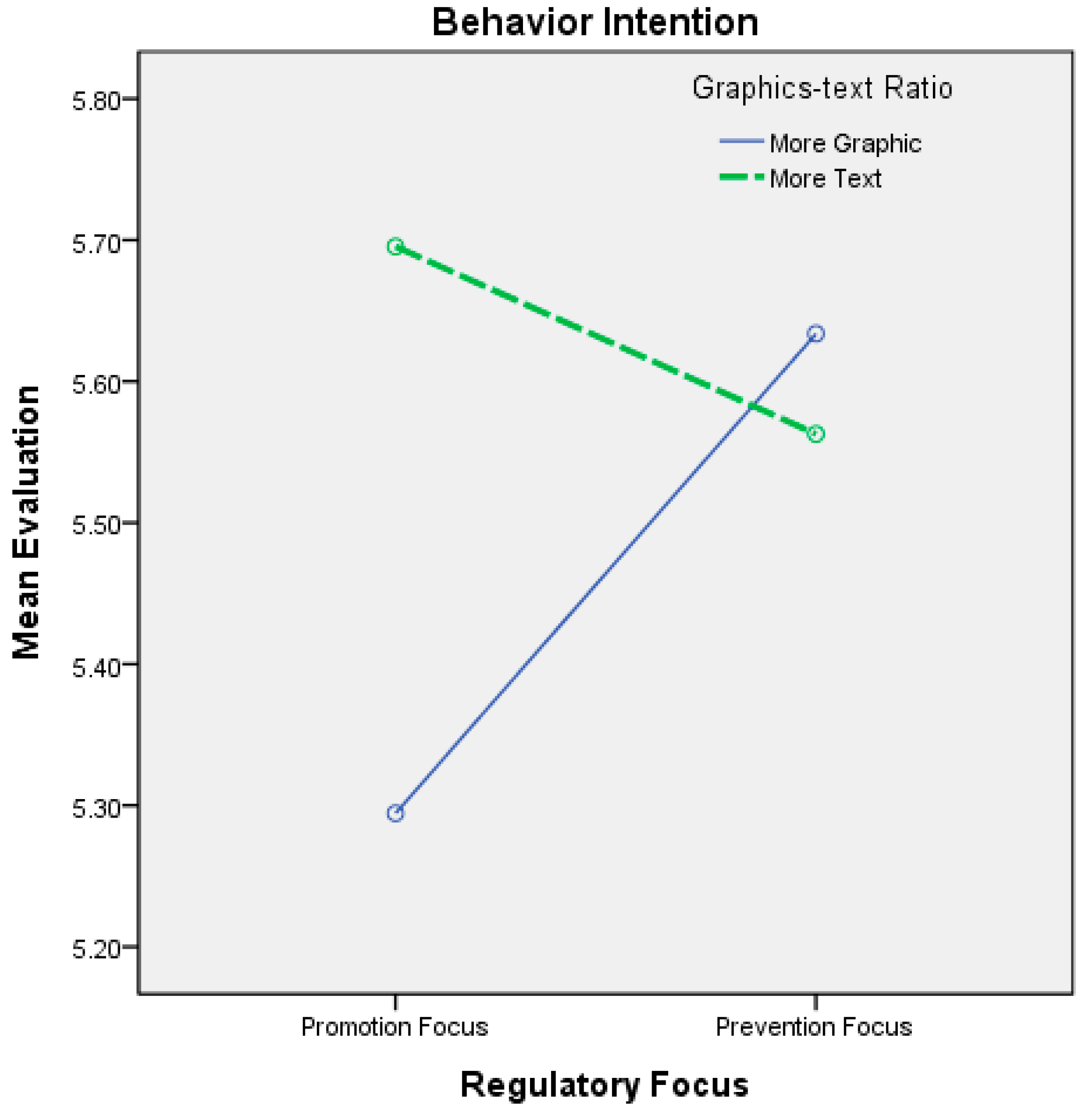3.1. Manipulation Test and Variable Measurement Reliability
Four questions were designed to test whether the temporal distances, graphics-text ratios and regulatory focuses were successfully designed. Samples were deleted if the temporal distance and graphics-text ratios were incorrect. A paired-samples t-test was used to analyze whether the regulatory focus had been successfully manipulated. The results revealed significant differences between manipulating the promotion focus and manipulating the prevention focus (Mpromotion = 5.8194 > Mprevention = 4.2176, t(107) = 9.141, p < 0.001). Regarding the prevention focus, the results showed that manipulating the prevention focus achieved significantly different results than manipulating the promotion focus (Mpromotion = 4.1343 < Mprevention = 5.8750, t(107) = 9.161, p < 0.001).
A reliability analysis of internal consistency revealed that the Cronbach’s α values for attitudes toward the ad and behavioral intentions were 0.943 and 0.892, respectively after items with lower reliability coefficient value were deleted (
Table 2). Both of these values were higher than 0.7, indicating that the questionnaire items were consistency of the scale.
Table 2.
Reliability of dependent variables.
Table 2.
Reliability of dependent variables.
| Items | Corrected Item-Total Correlation | Cronbach’s α if Item Deleted | Cronbach’s α |
|---|
| Attad1 | 0.734 | 0.938 | 0.943 |
| Attad2 | 0.702 | 0.939 |
| Attad4 | 0.696 | 0.940 |
| Attad5 | 0.779 | 0.936 |
| Attad6 | 0.728 | 0.938 |
| Attad8 | 0.780 | 0.936 |
| Attad11 | 0.764 | 0.937 |
| BI1 | 0.628 | 0.887 | 0.892 |
| BI2 | 0.744 | 0.869 |
| BI3 | 0.729 | 0.871 |
| BI4 | 0.784 | 0.863 |
3.2. MANOVA Result
The results of multifactor multivariate tests showed no statistically significant differences for the main effect (
Table 3). However, regarding the interaction effect between regulatory focus and the graphics-text ratios, significant differences were observed (F
(2,207) = 3.458,
p < 0.05). The results from analyzing the between-subject effects of the interactions between regulatory focus and graphics-text ratios on viewer attitudes toward the ad (F
(1,208) = 4.591,
p < 0.05) and viewer behavioral intentions (F
(1,208) = 2.972,
p < 0.05) were significant (
Table 4 and
Table 5). The effects of the interactions between the other independent variables on viewer attitudes toward the ad and viewer behavioral intentions were insignificant at the 0.05 significance level. According to Pandelaere
et al. [
36], a significance level of
p < 0.1 (marginal significance) signifies that a hypothesis has management implications. Therefore, our manipulation of the graphics-text ratios and temporal distances to influence viewers’ behavioral intentions (F
(1,208) = 2.610,
p < 0.1) had management implications.
Table 3.
Multivariate tests.
Table 3.
Multivariate tests.
| Effect | Value | F | Hypothesis df | Error df | Sig. |
|---|
| Regulatory focus | 0.004 | 0.391 | 2 | 207 | 0.677 |
| Graphics-text ratio | 0.011 | 1.158 | 2 | 207 | 0.316 |
| Temporal distance | 0.001 | 0.101 | 2 | 207 | 0.904 |
| Regulatory focus × Graphics-text ratio | 0.032 | 3.458 * | 2 | 207 | 0.033 * |
| Regulatory focus × Temporal distance | 0.005 | 0.525 | 2 | 207 | 0.592 |
| Graphics-text ratio × Temporal distance | 0.019 | 1.953 | 2 | 207 | 0.144 |
| Regulatory focus × Graphics-text ratio × Temporal distance | 0.002 | 0.228 | 2 | 207 | 0.796 |
Table 4.
Tests of between-subject effects for attitude toward advertisment.
Table 4.
Tests of between-subject effects for attitude toward advertisment.
| Source | Measure: Attitude toward Ad |
|---|
| Type III Sum of Squares | df | Mean Squared | F | Sig. |
|---|
| Regulatory focus | 0.271 | 1 | 0.271 | 0.382 | 0.537 |
| Graphics-text ratio | 0.048 | 1 | 0.048 | 0.068 | 0.795 |
| Temporal distance | 0.094 | 1 | 0.094 | 0.133 | 0.716 |
| Regulatory focus × Graphics-text ratio | 4.591 | 1 | 4.591 | 6.487 * | 0.012 |
| Regulatory focus × Temporal distance | 0.660 | 1 | 0.660 | 0.933 | 0.335 |
| Graphics-text ratio × Temporal distance | 1.809 | 1 | 1.809 | 2.556 | 0.111 |
| Regulatory focus × Graphics-text ratio × Temporal distance | 0.043 | 1 | 0.043 | 0.061 | 0.805 |
| Error | 147.211 | 208 | 0.708 | | |
| R-square | 0.052 | | | | |
Table 5.
Tests of between-subject effects for behavior intention.
Table 5.
Tests of between-subject effects for behavior intention.
| Source | Measure: Behavior Intention |
|---|
| Type III Sum of Squares | df | Mean Squared | F | Sig. |
|---|
| Regulatory focus | 0.571 | 1 | 0.571 | 0.760 | 0.384 |
| Graphics-text ratio | 1.454 | 1 | 1.454 | 1.936 | 0.166 |
| Temporal distance | 0.135 | 1 | 0.135 | 0.179 | 0.672 |
| Regulatory focus × Graphics-text ratio | 2.972 | 1 | 2.972 | 3.957 * | 0.048 |
| Regulatory focus × Temporal distance | 0.517 | 1 | 0.517 | 0.689 | 0.407 |
| Graphics-text ratio * Temporal distance | 2.610 | 1 | 2.610 | 3.475 ^ | 0.064 |
| Regulatory focus × Graphics-text ratio × Temporal distance | 0.328 | 1 | 0.328 | 0.437 | 0.509 |
| Error | 156.228 | 208 | 0.751 | | |
| R-square | 0.058 | | | | |
The interactions between temporal distance and the graphics-text ratio are shown in
Table 6 and
Figure 4. When the dependent variable was attitude toward the ad with one month of temporal distance, the participants’ attitudes toward the ad were more positive when the ad was concrete (
i.e., many graphics and little text) as opposed to when the ad was abstract. However, the difference was also not statistically significant. When the temporal distance was one year, the participants’ attitudes toward the ad were more positive when the ad was abstract (
i.e., a great deal of text and few graphics) as opposed to when the ad was concrete. However, this difference was not statistically significant, which directionally supports H1. Although the differences were not statistically significant for either temporal distance, the direction of the interaction effects supported our hypotheses on viewers’ attitudes toward the ad. The effects of the interactions between temporal distance and the graphics-text ratios on the participants’ behavioral intentions are shown in
Table 6 and on the right side of
Figure 4 and
Figure 5. When the temporal distance used was one month, the participants’ behavioral intentions were higher with concrete (
i.e., many graphics and little text) as opposed to abstract ads; however, the difference was not statistically significant, which partially supports H2. When the temporal distance was one year, the participants’ behavioral intentions were higher when the ad was abstract (
i.e., a great deal of text and few graphics) as opposed to when it was concrete. This difference was significant, which supports H2. Although the difference was not statistically significant for one month, the direction of the interaction effects supported our hypotheses on viewers’ behavioral intentions.
Table 6.
Interactions between temporal distance and the graphics-text ratio.
Table 6.
Interactions between temporal distance and the graphics-text ratio.
| Independent Variables | Temporal Distance | Graphics-Text Ratio | Sample Size | Mean | S.D. | Sig. (p-value) |
|---|
| Attitude toward Ad | One Month | Many graphics but little text | 56 | 5.5714 | 0.7603 | 0.360 |
| A great deal of text but few graphics | 48 | 5.4196 | 0.9227 |
| One Year | Many graphics but little text | 58 | 5.3153 | 0.9226 | 0.155 |
| A great deal of text but few graphics | 54 | 5.5476 | 0.7843 |
| Behavior Intention | One Month | Many graphics but little text | 56 | 5.6027 | 0.8591 | 0.749 |
| A great deal of text but few graphics | 48 | 5.5469 | 0.9163 |
| One Year | Many graphics but little text | 58 | 5.3017 | 0.8387 | 0.014 * |
| A great deal of text but few graphics | 54 | 5.7083 | 0.8765 |
The interactions between regulatory focus and the graphics-text ratio are shown in
Table 7 and
Figure 6 and
Figure 7. When the dependent variable was attitude toward the ad and the regulatory focus was promotion, the participants’ attitudes toward the ad were more positive when the ad was abstract (
i.e., a great deal of text and few graphics) as opposed to when it was concrete. The difference was significant. When the regulatory focus was prevention, the participants’ attitudes toward the ad were more positive when the ad was concrete (
i.e., many graphics and little text) as opposed to when it was abstract; however, the difference was not statistically significant. Although the difference was not statistically significant, the direction of the interaction effect supported our hypotheses on viewers’ attitudes toward the ad.
Figure 4.
Interaction effects between temporal distance and the graphics-text ratio on attitude toward advertisement.
Figure 4.
Interaction effects between temporal distance and the graphics-text ratio on attitude toward advertisement.
Figure 5.
Interaction effects between temporal distance and the graphics-text ratio on behavior intention.
Figure 5.
Interaction effects between temporal distance and the graphics-text ratio on behavior intention.
Table 7.
Interactions between regulatory focus and the graphics-text ratio.
Table 7.
Interactions between regulatory focus and the graphics-text ratio.
| Independent Variables | Regulatory Focus | Graphics-Text Ratio | Sample Size | Mean | S.D. | Sig. (p-value) |
|---|
| Attitude towards Ads | Promotion Focus | Many graphics but little text | 59 | 5.2567 | 0.8940 | 0.039 * |
| A great deal of text but few graphics | 49 | 5.5948 | 0.7662 |
| Prevention Focus | Many graphics but little text | 55 | 5.6390 | 0.7658 | 0.125 |
| A great deal of text but few graphics | 53 | 5.3881 | 0.9175 |
| Behavior Intention | Promotion Focus | Many graphics but little text | 59 | 5.2754 | 0.8581 | 0.014 * |
| A great deal of text but few graphics | 49 | 5.6939 | 0.8843 |
| Prevention Focus | Many graphics but little text | 55 | 5.6364 | 0.8261 | 0.106 |
| A great deal of text but few graphics | 53 | 5.5755 | 0.9088 |
Thus, H4 was partially supported. The effects of the interactions between regulatory focus and the graphics-text ratio on viewers’ behavioral intentions are also shown in
Figure 3. When the regulatory focus was promotion, the viewers’ behavioral intentions were higher when the ad was abstract (
i.e., a great deal of text and few graphics) as opposed to concrete. The difference was significant, supporting the first part of H4. When the regulatory focus was prevention, the participants’ behavioral intentions were higher when the ad was concrete (
i.e., many graphics and little text) as opposed to when it was abstract; however, the difference was not statistically significant. Although the difference was not statistically significant, the direction of the interaction effect partially supported our hypothesis on viewers’ behavioral intentions (H4).
Figure 6.
Interaction effects between regulatory focus and the graphics-text ratio on attitude toward advertisement.
Figure 6.
Interaction effects between regulatory focus and the graphics-text ratio on attitude toward advertisement.
Figure 7.
Interaction effects between regulatory focus and the graphics-text ratio on behavior intention.
Figure 7.
Interaction effects between regulatory focus and the graphics-text ratio on behavior intention.
3.3. Discussion
In this study, RFT and CLT were combined and used to identify the graphics-text ratios that improve the persuasiveness of health promotion ads. The participants’ construal levels were manipulated using varying temporal distances and different regulatory focuses. The results partially confirmed the validity of H1, H2, H3, and H4.
Although the literature on disease-related studies that use CLT have found significant differences when the temporal distance differed [
5,
12,
13], the main effect of temporal distance was not statistically significant in this current study. However, the between-subject effects of temporal distance and the graphics-text ratio on behavior intention were statistically significant. We investigated the interaction effect of temporal distance and the graphics-text ratio and found that the difference of behavior and attitude toward ads was bigger when the temporal distance was set as “in one year” than “in one month”. We surmised that this lack of significance could have occurred because the average age of participants in this study was approximately 27 years, which is too young to have sufficient knowledge regarding colorectal cancer, whereas the participants in previous studies were approximately 40 years or older [
37,
38].
The result of the between-subject effects of regulatory focus and graphics-text ratio on attitude toward the ads and behavior were statistically significant. Our results were consistent with previous research that reported that individuals with promotion focus preferred a high construal level, which indicates that they preferred abstract advertisements, and vice versa [
23,
37]. However, we determined that the interaction effects of regulatory focus and the graphics-text ratio were both directional and statistically significant when the manipulation was promotion focus. When the manipulation was prevention, only directional interaction effect was supported. If we recall the discussion in the preceding paragraph and previous research [
9,
23,
25], individuals were a regulatory fit when individuals with a promotion focus preferred the abstract goal strategy, and this preference often fit with far psychological distance. The participants in our study were far distant with respect to colorectal cancer and were more fit when they obtained abstract information such that the differences between more graphics and more text are more significant in the promotion focus than the prevention focus.
Another reason for the lack of significance might be the focus on the actual temporal distance and the psychological temporal distance. This study advocated colorectal cancer prevention. However, colorectal cancer generally occurs in individuals aged over 50 years. In this study, most of the participants were aged 27 years or younger. Thus, they were influenced by a high-level construal of colorectal cancer regardless of the temporal distances used in the advertising messages. The participants thus processed the information via high-level construal, which differed significantly from this study’s hypothesis that a low-level construal design would be appropriate for a close temporal distance. Therefore, we inferred that the effects of the interactions between regulatory focus and graphics-text ratio on participants’ attitudes toward the ad and their behavioral intentions were not statistically significant (despite showing the correct direction) because we miscalculated the temporal distances and graphics-text ratios.
Regarding our manipulation of the regulatory focus, the results of the overall interactions showed that a regulatory focus influenced how viewers processed information. When we triggered the participants’ prevention focus, they used low-level construal to process the information. Conversely, when we triggered their promotion focus, they used high-level construal to process information. For the first group, the ads with many graphics and little text produced superior advertising effectiveness. For the second group, the ads with a great deal of text and few graphics created superior advertising effectiveness. These results supported the findings from previous studies [
23,
38,
39]. We inferred that no statistically significant differences were observed for the prevention focus group regarding their attitudes toward the ad or their behavioral intentions because colorectal cancer generally occurs in people aged older than 50 years in Taiwan, and most of the participants in this study were aged 27 years or younger. Thus, these participants felt relatively psychologically distant from the disease, and they adopted high-level construal and the promotion focus to process information. As such, the ads with a great deal of text but few graphics were the most effective.
